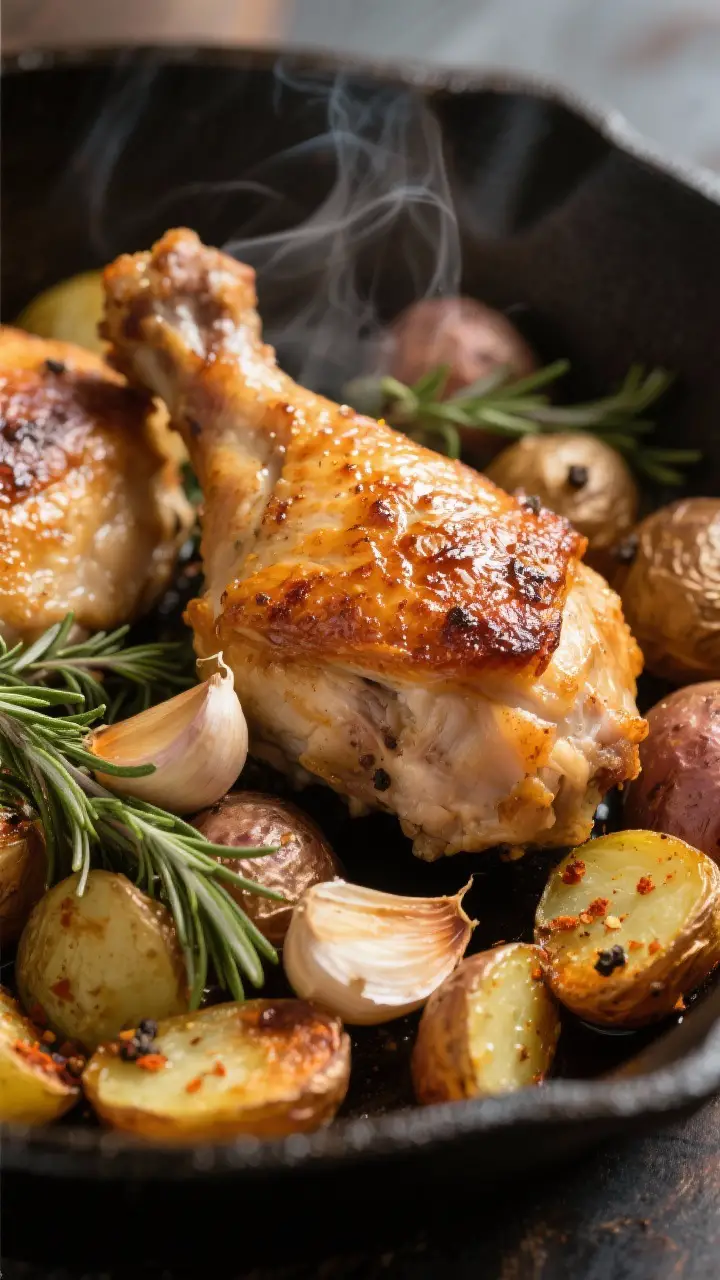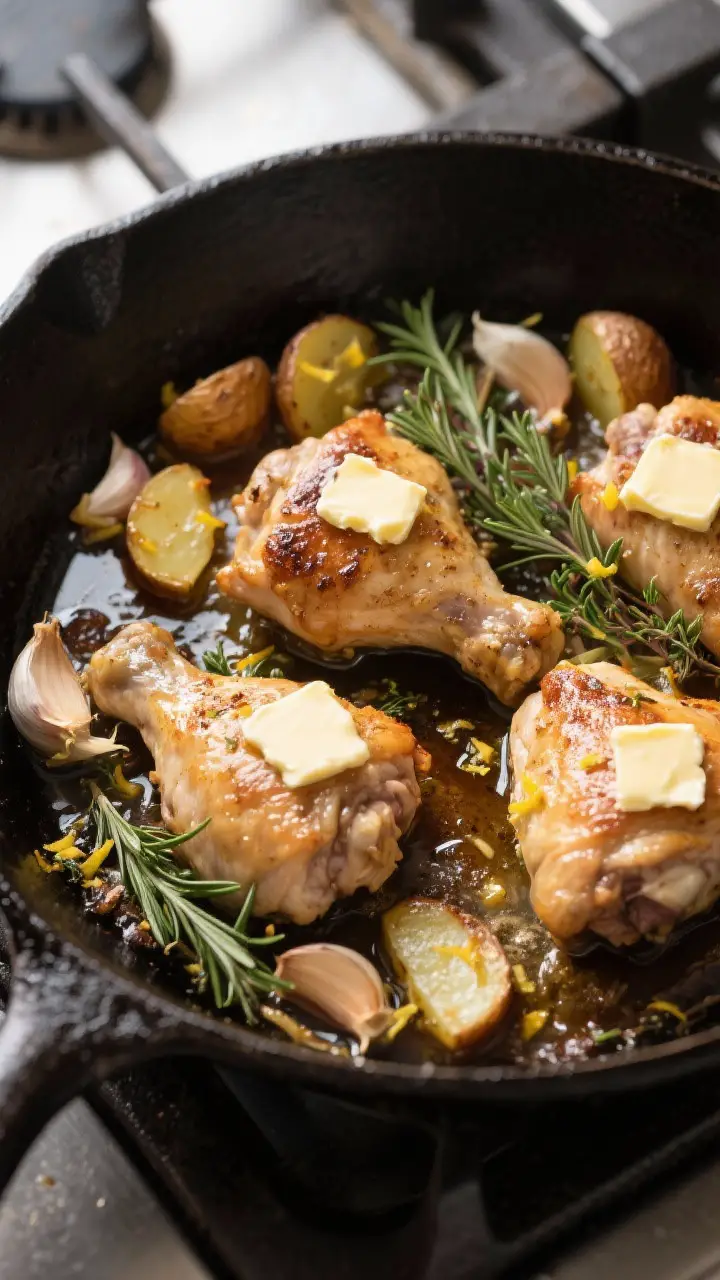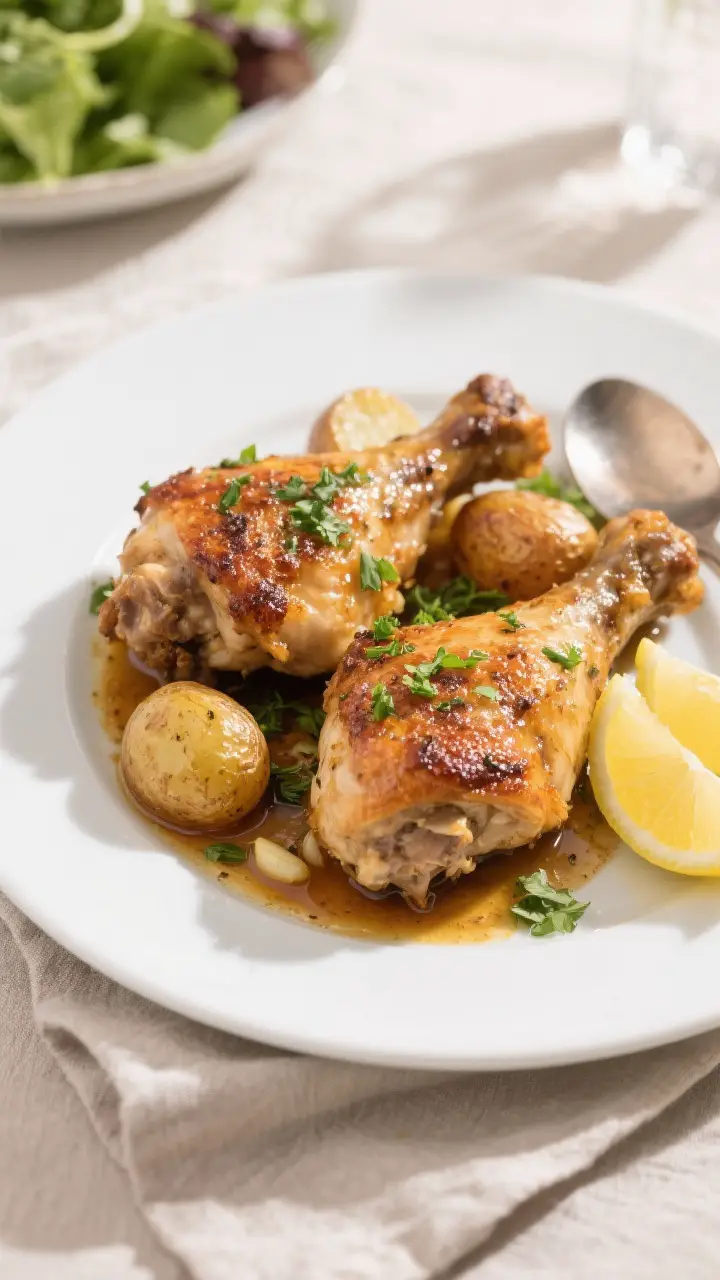This is the kind of dinner you make when you want big flavor without a big mess. Golden, crispy chicken thighs nestled with tender potatoes and bright, herby aromatics—all in one pan. The garlic gets toasty and fragrant, the herbs do the heavy lifting, and the chicken stays juicy.
It’s a reliable, repeatable meal that works on busy weeknights or casual weekends. If you love simple food that tastes like more than the sum of its parts, this will hit the spot.
Why This Recipe Works

- Bone-in, skin-on thighs stay juicy: The skin locks in moisture and crisps up beautifully while the dark meat stays tender.
- High heat plus a good sear: You get that restaurant-style golden crust without deep frying.
- One pan, layered flavor: Searing the chicken first infuses the oil, which then seasons the potatoes and aromatics.
- Garlic and herbs do the heavy lifting: Minimal ingredients, maximum flavor. No complicated marinades required.
- Flexible and forgiving: Swap herbs, add veggies, or use what you have.
It still turns out great.
Ingredients
- 6 bone-in, skin-on chicken thighs (about 2.5–3 pounds)
- 1.5 pounds baby potatoes, halved (or Yukon Golds cut into chunks)
- 6–8 garlic cloves, smashed (some whole, some roughly chopped)
- 2 tablespoons fresh rosemary, finely chopped (or 2 teaspoons dried)
- 2 tablespoons fresh thyme leaves (or 2 teaspoons dried)
- 1 tablespoon fresh parsley, chopped (for finishing)
- 1 teaspoon dried oregano (optional but nice)
- 1 lemon: zest and halves for finishing
- 3 tablespoons olive oil
- 1 tablespoon unsalted butter (optional, for extra gloss and flavor)
- 1/2 cup low-sodium chicken broth or dry white wine
- 1 teaspoon smoked paprika (or sweet paprika)
- 1/2 teaspoon red pepper flakes (optional)
- Kosher salt and freshly ground black pepper
How to Make It

- Pat the chicken dry. Use paper towels to remove surface moisture. This step is key for crisp skin. Season generously with salt, black pepper, and the smoked paprika on both sides.
- Preheat and prep the pan. Set a large oven-safe skillet or braiser (12 inches or larger) over medium-high heat.
Add 2 tablespoons olive oil and heat until shimmering.
- Sear the chicken skin-side down. Place thighs skin-side down and don’t move them for 6–8 minutes, until deep golden and crisp. Flip and cook the other side for 3–4 minutes. Transfer to a plate.
Leave the flavorful drippings in the pan.
- Build the flavor base. Reduce heat to medium. Add the remaining 1 tablespoon olive oil if needed. Stir in the smashed garlic and cook 30–60 seconds until fragrant, not burned.
- Season the potatoes. Add potatoes to the pan with a pinch of salt and the dried oregano (if using).
Toss in the rosemary and thyme. Stir to coat in the garlicky oil, letting the potatoes get a little color for 3–4 minutes.
- Deglaze and brighten. Pour in the broth or wine and use a wooden spoon to scrape up browned bits. Stir in lemon zest and red pepper flakes.
- Nestle the chicken back in. Return thighs to the pan, skin-side up, on top of the potatoes.
Add the butter in small pats around the pan for a silky finish.
- Roast to finish. Transfer the pan to a 400°F (200°C) oven. Roast 18–25 minutes, until the thickest part of the thighs reaches 175–185°F for tender, pull-apart meat. The potatoes should be fork-tender.
- Rest and finish with lemon. Squeeze the lemon halves over the chicken, sprinkle with parsley, and let rest 5 minutes.
Taste and adjust salt and pepper.
- Serve. Spoon the pan juices over the chicken. Add a simple green salad or steamed green beans if you want something fresh on the side.
Keeping It Fresh
- Storage: Cool completely, then refrigerate in an airtight container for up to 4 days.
- Reheating: For best texture, reheat in a 350°F oven for 12–15 minutes, or skillet-warm over medium heat with a splash of broth. Microwave works, but the skin won’t be crisp.
- Make-ahead: Season chicken up to 24 hours in advance and store uncovered in the fridge.
Dry skin going in means crisp skin coming out.
- Freezing: Freeze portions (without potatoes if possible) up to 3 months. Thaw overnight in the fridge, then reheat in the oven.

Why This is Good for You
- Protein-rich: Chicken thighs deliver satisfying protein to keep you full longer.
- Healthy fats: Olive oil and chicken fat add flavor and help absorb fat-soluble nutrients from herbs and potatoes.
- Herbs and garlic: Rosemary, thyme, and garlic bring antioxidants and anti-inflammatory compounds, plus big flavor without extra sodium.
- Balanced plate: You get protein, carbs, and a bit of healthy fat in one pan. Add greens to round it out.
Pitfalls to Watch Out For
- Skipping the pat-dry step: Wet skin won’t crisp.
Blot the thighs well before seasoning.
- Overcrowding the pan: If the chicken is crammed, it steams. Use a large skillet or work in batches for a proper sear.
- Burning the garlic: Garlic turns bitter if it goes too long. Add it after searing and keep the heat moderate.
- Underseasoning: Thighs can handle salt.
Season both sides and taste the pan juices at the end.
- Pulling too early: Thighs shine at 175–185°F. That extra time breaks down connective tissue and keeps them tender.
Variations You Can Try
- Italian-ish: Add cherry tomatoes and olives in the last 10 minutes. Finish with basil instead of parsley.
- Smoky paprika and citrus: Replace rosemary with a mix of smoked paprika and cumin.
Finish with orange zest and juice.
- Mustard-herb pan sauce: After roasting, remove chicken, whisk 2 teaspoons Dijon into the pan juices over low heat and reduce slightly.
- Veggie boost: Add carrots, fennel wedges, or Brussels sprouts with the potatoes. Cut to similar sizes so they cook evenly.
- Dairy-free richness: Skip the butter; add a drizzle of extra-virgin olive oil at the end for gloss.
- No oven: After searing, cover the pan and simmer on low until cooked through, then uncover for the last few minutes to re-crisp the skin.
FAQ
Can I use boneless, skinless thighs?
Yes. Reduce the roasting time to about 12–15 minutes after searing, and watch closely.
You’ll lose the crispy skin, but the flavor is still great.
Can I make this with chicken breasts?
You can, but use bone-in, skin-on breasts for better moisture. Sear as directed, then roast to 160–165°F internal temp to avoid drying out.
What if I don’t have fresh herbs?
Use dried. As a rule, use about one-third the amount of dried herbs compared to fresh.
Add dried herbs earlier so they have time to bloom.
How do I know the chicken is done?
Use an instant-read thermometer. Aim for 175–185°F for thighs. If you don’t have a thermometer, pierce near the bone; juices should run clear and the meat should feel tender.
Can I swap the potatoes for something else?
Absolutely.
Try cauliflower florets, sweet potatoes, or butternut squash. Adjust size so they cook in the same time frame.
What size pan should I use?
A 12-inch cast-iron or stainless skillet is ideal. Anything smaller risks overcrowding, which prevents browning.
Is white wine necessary?
No.
Chicken broth works perfectly. The wine adds complexity, but the dish is still delicious without it.
How do I keep the skin crispy?
Start with dry chicken, sear well, and roast uncovered. Rest briefly before serving, but don’t tent with foil—that traps steam and softens the skin.
Final Thoughts
One-pan garlic herb chicken thighs deliver comfort and flavor with minimal fuss.
You get crispy skin, tender meat, and rich, garlicky potatoes in under an hour, mostly hands-off. Keep it simple, swap in what you have, and let the pan do the work. This is the kind of meal that becomes a household regular—easy, reliable, and always satisfying.

